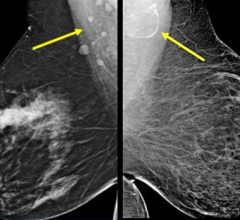
Greg Freiherr has reported on developments in radiology since 1983. He runs the consulting service, The Freiherr Group.
Toward a Better, Gentler Way to Image Breast Cancer
Minimizing X-ray dose has driven the global imaging community to develop technologies that today can cut patient dose from computed tomography (CT) to a fraction of its previous levels. So it may soon be in mammography.
Earlier this year, the U.S. Food & Drug Administration (FDA) granted permission for Hologic to sell its Selenia Dimensions, a machine that through its ability to perform tomosynthesis offers mammographers a chance to see what otherwise might be hidden. Multiple X-ray exposures at varying angles promise to expose lesions obscured by overlying tissues and increase diagnostic certainty.
Unfortunately, to achieve the full potential of this technology, the tomo scan must be read in the context of a 2-D mammogram. This requires two exams, doubling the patient’s dose of radiation. While little has been said so far about this, just as it was for CT, dose could become an issue for tomosynthesis, giving pause to some whose patients might otherwise benefit from tomo. But work is already underway to create an arsenal of silver bullets.
Researchers at the University of Pittsburgh hope to craft one such a bullet against dose, an algorithmic one in the shape of a “synthetic full-field digital mammography (FFDM)." The goal is to synthesize data for a 2-D image from those obtained during the tomo scan, thus sparing the patient from a second exposure to radiation. If successful, the tomo exam would capture all the data mammographers need.
Promising to improve tomo further is a nanotechnology that could increase scan speed by a factor of 10, boosting spatial resolution and opening the door to dual-energy scanning, potentially providing better contrast and, in the process, reducing radiation dose. This technology would replace the moving X-ray source in tomo with a stationary one, called multi-pixel field emission X-ray, which is based on microscopic carbon nanotubes. The feasibility of doing so has already been demonstrated and a fully functional system is in development at a company called XinRay Systems, a joint venture between Siemens and a small North Carolina startup called Xintek.
On the detector side, at the State University of New York in Stony Brook, researchers are working on a new amorphous selenium detector that could double the detective quantum efficiency (a measure of X-ray detector performance), boosting resolution far beyond what is currently possible and, potentially reducing dose.
With its volumetric data sets providing different angles on suspicious lesions, today’s breast tomosynthesis is hard to argue against. Tomorrow it may be even more so, as the evolution of this technology renders issues about dose less and less of an issue.


 May 15, 2024
May 15, 2024 








